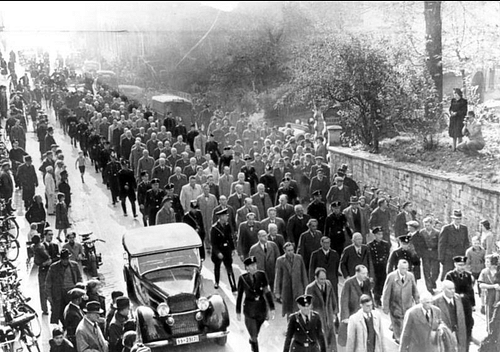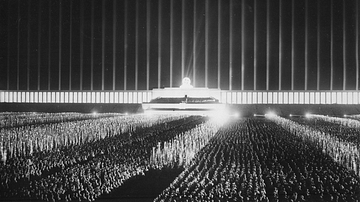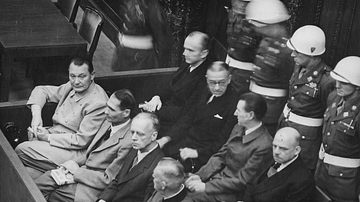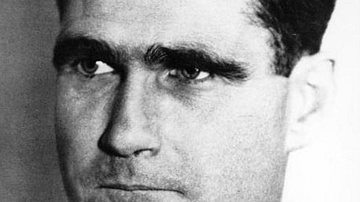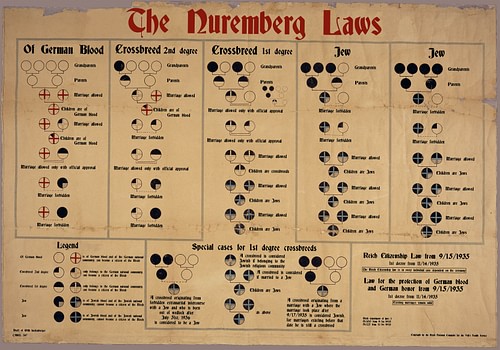
The Nuremberg Laws of September 1935 were a set of racial laws which set out a number of restrictions on Jewish people such as depriving them of the right to German citizenship and right to marry non-Jews. Amendments to the laws then defined who exactly was to be identified as a Jew in Nazi Germany.
The laws, formulated at Nürnberg, were another phase of Adolf Hitler's 'solution' to the question of just how to remove Jewish people from German territory, a process which ended in the 'Final Solution', the murder of 6 million Jewish people in Nazi-run death camps.
The Nazis & the Jews
The leader of Nazi Germany Adolf Hitler (1889-1945) was determined to create scapegoats for the ills of the Weimar Republic, created in 1918. The Nazis wanted to boost their own popularity by identifying common enemies. The principal Nazi scapegoat were the Jewish people living in Germany. As far back as his book Mein Kampf, published in 1925, Hitler had identified the Jews as a group which he considered was holding Germany and the pure Germanic Volk (people) back from their true potential. Once they had gained power in 1933, Hitler and the Nazis were determined to make life as difficult as possible for Jewish people. The Enabling Act (The Law for Removing the Distress of the People and the Reich) was passed on 23 March 1933. This act allowed Hitler to pass laws without needing to go through the parliament.
The Nazis systematically removed Jews from small villages and towns, moving them into the cities. There were boycotts of Jewish businesses. Emigration was actively encouraged, although the state often seized assets and only let the departing take the minimum of possessions. The Law of the Restoration of the Professional Civil Service was passed in April 1933 and meant that Jewish people were forbidden from holding government and official administrative positions. There were, too, restrictions or impediments in several other professions such as law or medicine. Jewish people suffered many other discriminations in daily life and physical persecution from the Nazi paramilitary groups the Sturmabteilung (SA) and Schutzstaffel (SS).
The Race Laws
The next significant restriction on Jewish people came with the Nuremberg Laws of 15 September 1935, the initial ideas for which were presented by Hitler at the 1935 Nuremberg Rally, the annual Nazi party gathering. A meeting of Nazi civil servants and party members immediately drew up the laws at Nuremberg, hence their name. An extraordinary meeting of what remained of the German parliament convened, not at the Reichstag (which had been gutted by the Reichstag fire of February 1933), but in the Nuremberg Hall of Cultural Association, and it passed the new measures which thus became enshrined in law.

The key features of the three Nuremberg Laws included the following:
The Reich Flag Law
- The national colours were identified as black, red, and white. The national flag was now the Nazi swastika flag.
The Law for the Protection of German Blood and German Honour
- Jews could not marry non-Jews.
- Marriages between Jews and non-Jews were annulled.
- Jews and non-Jews were forbidden from extra-marital relationships.
- Jews could not employ non-Jewish women under the age of 45 in their homes.
- Jews could not fly the German national flag or wear national colours, but they could display Jewish symbols.
The Law of the Reich Citizen
- Jews could not be citizens of Germany, and so their civic rights were limited.
- A citizen of Germany (i.e. a non-Jew) must be willing to serve the needs of the state and was identified by possession of a citizen certificate.
Punishments for breaking any of the Nuremberg Laws, particularly by a Jew, usually entailed imprisonment, sometimes including hard labour, depending on the offence. There were public humiliations (being made to wear a placard, for example) and beatings for such offences as a German citizen engaging in romantic relations with a Jew. Conformity became the watchword of everyone. For non-Jewish Germans, the stipulation that a citizen must have a certificate was a clever way for the Nazi party to ensure that people went along with and did not react against the regime, since if they did, they could lose their certificate and so their citizenship.
'Purity of Blood'
The Nuremberg Laws, then, were a double-edged sword that cut Jewish people from the citizen body and strengthened what Hitler described as the 'purity of blood' (McDonough, 63) of the remainder. As far back as 1920, the Nazi party programme had included just such a racial policy:
Point 4. None but members of the nation may be citizens of the state. None but those of German blood, whatever their creed, may be members of the nation. No Jew therefore may be a member of the nation.
(McDonough, 111)
Hitler was, above all, concerned with creating a 'Master Race' (Herrenvolk), that is, the strongest possible elements of 'Aryan' Germanic peoples, 'Aryan' being vaguely defined as those people Hitler considered capable of creating culture. In Hitler's rather mixed-up and often nonsensical racial theory, 'non-Aryans' are not capable of creating but only destroying cultures, and so they are inferior. As the 'Aryans' are superior, they have the right to subjugate everyone else. Further, human history, society, and warfare, according to Hitler, are all a constant battle between these superior and inferior races.
Hitler wanted to artificially create, or rather, to speed up what he considered the natural process of distilling from the general populace a pure 'Aryan' folk community of Germanic people, a Volksgemeinschaft, that is a traditional community held together by common blood ties and the will of a strong leader (himself, of course). Hitler's artificial catalyst in this process, what he repeatedly called a 'struggle' towards racial purity, was the Nuremberg Laws and, after that, a long series of even more aggressive policies. Jewish people were not the only target of Hitler's warped racial theory, non-race groups like Marxists and the physically or mentally disabled were also targeted. Indeed, the treatment of the Jews by the Nuremberg Laws and their practical consequences was used very much as a model that was applied to many other groups the Nazis identified as enemies of a prosperous society.

Identifying Jews
Some moderates in the Nazi party were concerned about the harm that attacks and boycotts on Jewish people did for general business and the health of the economy while more extreme Nazis wanted even stronger measures and a total annihilation of the Jewish people in Germany. Historical studies of the public reaction to the Nuremberg Laws give mixed results – agreement, disagreement, and indifference to varying degrees – but one thing is clear, the majority of the population hoped that the establishment of legal boundaries would at least end the lawlessness of the seemingly random attacks of the Nazis on German citizens. Identifying precisely who the Jewish people and who the non-Jewish people were would clarify the situation and give some security to people who were not Jewish. A pressing question for the Nazis, then, was who exactly were the Jews? A November 1935 amendment to the Nuremberg Laws stipulated that any person with three or four Jewish grandparents was officially henceforth classified by the state as being a Jew. People of mixed heritage were called Mischlinge, and restrictions on these people depended on the proportion of Jewish heritage. As the historian S. Friedländer notes, “Proof that one was not of Jewish origin or did not belong to any 'less valuable' group [e.g. Romani] became essential for a normal existence in the Third Reich (153).
A Greater Persecution of the Jews
There were some voices of protest against the Nuremberg Laws, not only from Jewish people and the foreign press but also from such figures as Dietrich Bonhöffer (1906-1945), a minister in the Protestant Confessional Church. Bonhöffer, like so many who criticised the Nazi regime, was imprisoned, detained in a concentration camp, and executed. The Communists, now officially banned as a political party, continued underground to work against Nazi propaganda and measures like the Nuremberg Laws by distributing leaflets and posters criticizing such discriminatory measures. Many Jewish people, however, still could not imagine that the Nuremberg Laws were only the beginning of an even more sinister set of Nazi policies yet to come. Those who did realise things could only get worse and who had the means and opportunity took the difficult decision to leave Germany.
By 1938, half of Germany's 500,000 Jewish people had emigrated, and the number of Jewish businesses in Germany had shrunk from 50,000 (1933) to 9,000. For Hitler, this was not enough. The ominous steps to a violent solution to what Hitler described as 'the Jewish Question' (Judenfrage), began with the Kristallnacht. The Kristallnacht (Reichkristallnacht, 'Night of Broken Glass', or November Pogrom) was an attack on Jews and Jewish property across Germany and Austria on 9-10 November 1938. Over 1,000 synagogues were attacked, 267 of which were wrecked beyond repair or burnt to the ground. 7,500 shops, including 31 large department stores owned by Jews, had their windows smashed (hence the Kristallnacht name) and their property looted. Jews were beaten in the street, arrested in their homes, and confined without trial. According to the official records, 91 Jews were killed in the attacks, but the real figure was likely much higher.
After Kristallnacht, the persecution of the Jews only increased. Jewish children were not permitted to return to school, and curfews were imposed. Jews could not attend cinemas or travel with non-Jews on trains, they were not permitted to own a car, buy cigarettes, or enter public parks. Jewish property continued to be confiscated on a large scale. Jewish businesses and the Jewish press were systematically closed down and then prohibited. Seemingly random imprisonments and transportation to labour camps became more and more common.
Unsurprisingly, Jewish people across German territories now emigrated in even larger numbers than before. In Germany, "by 1939, three hundred thousand Jews, broadly speaking the younger section of the community, had emigrated" (Stone, 89). 100,000 Jewish people fled Austria, part of the German Reich since the Anschluss of March 1938. The loss to the Third Reich came in all areas of life as Jewish writers, musicians, doctors, and scientists left en masse. Such was the movement of people that many states began to pass laws that restricted immigration, Jewish people in particular. Tragically, though, tens of thousands of migrant Jewish people, who thought they had reached safety, only found themselves in any case under Nazi rule following the occupation of Western Europe during the Second World War (1939-45). The Nuremberg Laws were applied to these occupied territories. Rounded up in ghettos, much worse was to come as the Nazis and their allies began to systematically murder Jews and other "undesirables" in secret death camps like Auschwitz-Birkenau. Ultimately, The Nazi's "Final Solution" resulted in the Holocaust, that is the murder of six million European Jews.

